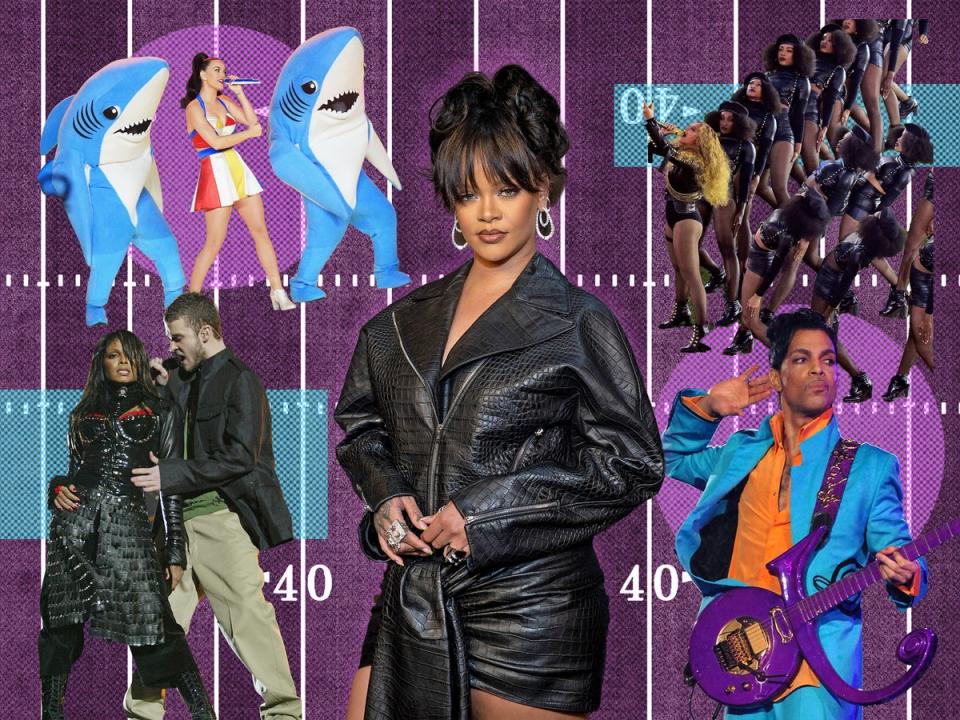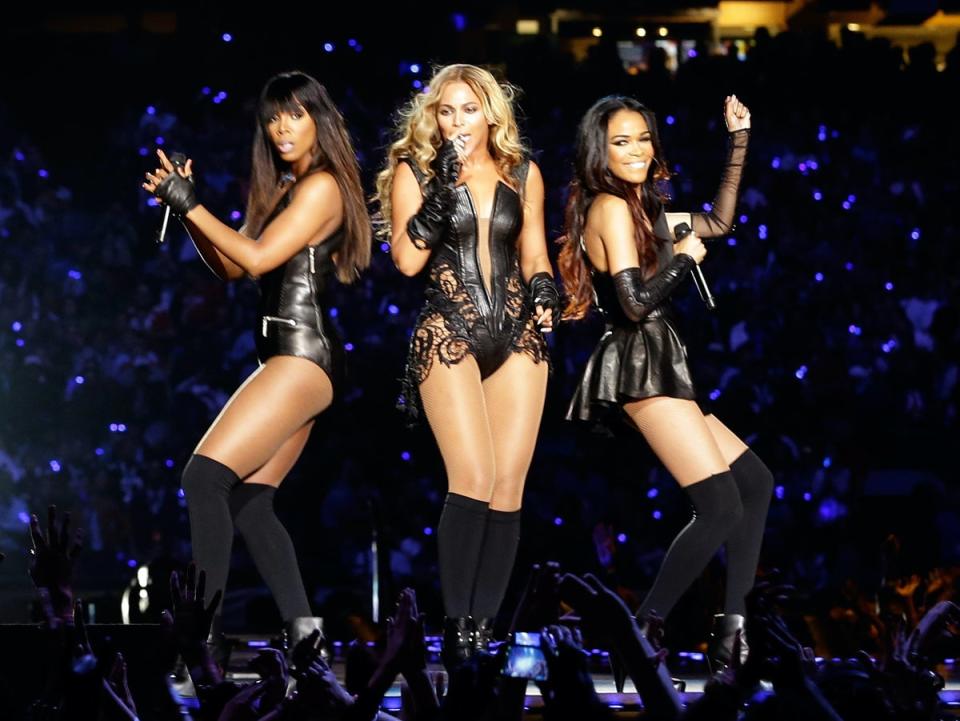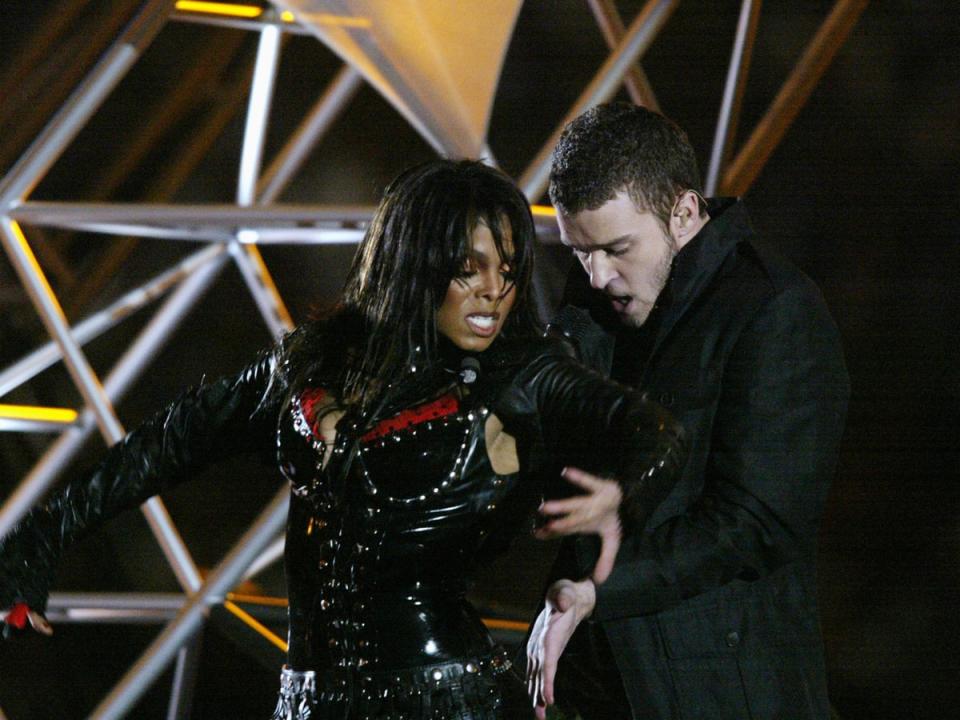Nipples, sharks and police protests: Inside the madness and mishaps of the Super Bowl half-time show
- Oops!Something went wrong.Please try again later.
- Oops!Something went wrong.Please try again later.
- Oops!Something went wrong.Please try again later.
- Oops!Something went wrong.Please try again later.

In just 12 seconds of fast-cut posing, strafed with stadium lights, Rihanna got more pulses racing than a full three hours of American football. The teaser clip posted online from rehearsals for Ri-Ri’s forthcoming half-time show at the Super Bowl LVII might not have revealed much about her plans, beyond the likelihood of her performing in an outfit from the limited-edition Game Day collection from her own Savage X Fenty fashion line (key slogan: “Rihanna concert interrupted by a football game, weird but whatever”). But for her fans, this was last-second-touchdown stuff: the 2023 Super Bowl will mark her first live performance since the Grammys in 2018 and, considering the half-time show’s claim on the title of biggest pop show on Earth, it’s expected to be a comeback drop-kicked clean out of the park.
After all, over the past 30 years the half-time show has become renowned as the year’s greatest miniature musical extravaganza, the 12-minute stadium show-cum-Olympic Opening Ceremony you can construct in just six minutes. Boasting over 100 million viewers in 180 countries and America’s biggest annual TV audience, it demands the most eye-catching spectacles. Last year, a who’s who of rap music including Dr Dre, Snoop Dogg, Kendrick Lamar and Eminem fired out a torrent of hip-hop classics from atop a futuristic block party. In 2021, The Weeknd played on a miniature city built into the stands of Tampa’s Raymond James Stadium and peopled by hundreds of purple-eyed ghouls and psycho-masked redcoats. Back in 2015, Katy Perry rode a gigantic, geometric golden tiger to the 30-yard line and flew around the stadium on a firework. Carpool Karaoke this decidedly is not.
Given an entire football pitch and a budget apparently as roofless as the stadium itself to play with (production costs have been known to top $10m), the half-time show has developed into a testing lab for the possibilities of the pop spectacular and a mixing pot of A-list talent. Want to know what Coldplay might do with several marching bands, a children’s orchestra, a couple of hundred giant flowers and Bruno Mars and Beyonce’s phone numbers? How Lady Gaga might abseil from the roof of a stadium onto a 50ft rendition of Liberty’s torch? Or simply watch through your fingers for more mishaps, controversies and meme moments from the self-declared birthplace of the “wardrobe malfunction”? Tune right in.
It wasn’t always thus. From its origins at the very first Super Bowl in 1967, the half-hour interval performance initially involved all-American parades across the field by university marching bands and cheerleaders. Occasionally, singers such as Andy Williams, Ella Fitzgerald or Carol Channing provided musical salutes to jazz greats such as Louis Armstrong and Duke Ellington. Some years would have Mardi Gras, Caribbean, Motown or Big Band themes, or be dedicated to American music, film and history. Others would see Walt Disney fill the field with cartoon characters and Mouseketeers; a celebration of the 40th anniversary of Peanuts; Miss Texas 1974 playing a fiddle solo; and, in 1989, an Elvis impersonator called Elvis Presto doing large-scale card tricks.
As the event increasingly took on a Vegas scale during the Eighties, regular performances by inspirational soul-pop band Up With People highlighted its musical potential. It wasn’t until the 25th Super Bowl in 1991, though, that it transformed into a unit-shifting star vehicle. Superstar boyband New Kids On The Block made a brief appearance during an all-kid Walt Disney World production that was otherwise, essentially, a very cute plug for Operation Desert Storm. The following year, Gloria Estefan rose above a winter-themed show full of snowmen and ice skaters on one of the half-time show’s many floating podiums. And the whole nature of the event shifted in 1993, when Michael Jackson leapt out of a flume of fireworks for a medley of hits flanked by groin-clutching cops. Within 12 minutes, he’d conjured enormous tile pictures of children from the stands at the wave of a magic stick and surrounded himself with kids of all nations beneath a huge inflatable globe, singing “Heal The World”. Sales of his Dangerous album shot up 83 per cent in the following week and, suddenly, the A-listers wanted in.
For several years, the half-time show became a large-scale musical revue, where acts including Patti Labelle, ZZ Top, Boyz II Men, Stevie Wonder, Christina Aguilera and Phil Collins would share the world’s biggest – and most lucrative – stage. The shows themselves stayed corny, though, honouring The Blues Brothers, plugging a new Indiana Jones ride, or just wanging on about world peace in general.
Then, in 2001, the schmaltzy themes were dropped and this prime slice of televisual real estate was given over to major pop and heritage rock acts belting through the hits at a breakneck pace. Aerosmith and 'N Sync united as AeroSYNC for 2001’s Kings of Rock and Pop show, a bizarre culture clash made all the more jolting by random guest spots from Britney Spears, Mary J Blige and Nelly. The following year U2 delivered “Where the Streets Have No Name”, while the names of the victims of 9/11 scrolled up a giant fabric screen. Through the 2000s, Paul McCartney, Prince, Tom Petty and Bruce Springsteen all reeled out the favourites, and The Rolling Stones brought the event’s biggest stage to the 40th Super Bowl in 2006. Constructing their lips logo the length of the field, they filled the tongue section with partying fans. In the past decade, though, the half-time show found its natural soulmate in the spectacle of the major pop act. Madonna as the she-Zeus of a golden procession through a vogueing Olympus in 2012. Or Beyonce reuniting Destiny’s Child via surprise trapdoor in 2013.

The shift understandably gave the production crews limitless headaches. “We have to start in the parking lot and in six minutes we have to get all of this equipment onto the field in position, plugged in, in the dark, checked and working,” the Super Bowl’s sound engineer Patrick Baltzell told The Verge in 2018. While most performers sing live to pre-recorded tracks to smooth this boil-in-the-bag extravaganza, The Stones insisted on having their full band set-up plugged in. Audio perfectionist Prince, meanwhile, initially rejected Baltzell’s usual trolley PA system that can be rolled on in seconds, and demanded stadium-gig speakers be installed in 2007 to relay his typically electric “Purple Rain” solo, which rivalled the lightning storm he played it in. He only backed down when informed they’d never fit through the 10ft-wide player tunnels in time.
The scale and pace of the show also makes mishaps and misfires all-too common. No one who heard Fergie from Black-Eyed Peas groan and gnaw her way through “Sweet Child O’ Mine” with Slash in 2011 has yet managed to scrape the sound of it from their eardrums. M.I.A. was sued for $16.6m for flipping the bird at the crowd on the most primetime of television while performing as Madonna’s Roman empress sidekick: “@madonna ummm … can I borrow 16 million?” she tweeted. And despite her gargantuan stunts and stage sets in 2015, Katy Perry was memorably upstaged by viral internet sensation Left Shark. The poor dancer struggling to keep up with a beach-themed routine for “Teenage Dream” because they were doing it in a cumbersome foam shark suit and likely distracted by all the massive singing beach balls.
All of which pales in comparison to the 2004 half-time show, the very reason that the Super Bowl steered clear of pop acts for the following seven years straight. The moment when Justin Timberlake pulled the breastplate from Janet Jackson’s Alexander McQueen leather outfit at the line “gonna have you naked by the end of this song” from his “Rock Your Body” single, exposing her breast to 140 million viewers, swiftly became one of the most notorious moments in live broadcasting history. It sent shockwaves across conservative America (over 500,000 Americans complained, compared to around 50 Canadians) and had societal repercussions far beyond spawning the phrase “wardrobe malfunction”.
The official explanation was that Timberlake only meant to reveal Jackson’s red lace bra, and that unpredictable lingerie was to blame for the “accident”. But a $550,000 fine was imposed (and later rescinded) against the CBS channel for obscenity over “Nipplegate”. The decision instigated an overnight censorship clampdown across the US media and had a devastating effect on Jackson’s career which was far more revealing than the “malfunction” itself. The fact that she was immediately cut from movies and award ceremonies and blacklisted by many TV and radio channels worldwide, while Timberlake was left virtually unscathed career-wise, spoke volumes about America’s underlying views on women and minorities. Meanwhile, amid the scandalised rush to view the incident online – which made “Janet Jackson” the most searched term in internet history and gained digital platform TiVo an estimated 35,000 new subscribers – three guys named Jawed Karim, Steve Chen and Chad Hurley were so frustrated that they couldn’t find the clip anywhere that they came up with the idea for a more public-led digital streaming platform. They called it YouTube.

The latest Super Bowl half-time controversy came in 2019, when Maroon 5 were criticised for performing after numerous major artists refused to play the slot in protest at the NFL’s shunning of former San Francisco 49ers quarterback Colin Kaepernick, who had begun taking the knee against racism and police brutality during the US national anthem in 2016. Amongst those objecting was Rihanna. “I couldn’t dare do that,” she told Vogue about having turned down the 2018 Super Bowl. “Who gains from that? Not my people. I just couldn’t be a sellout. I couldn’t be an enabler.” Now, she claims ahead of this year’s show, “I have to rise to that challenge.”
No matter how much pizzazz she throws at it, then, Rihanna’s show is already guaranteed its place among the half-time show’s more divisive appearances. There’s a ball game, too? Weird, but whatever.

